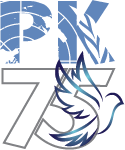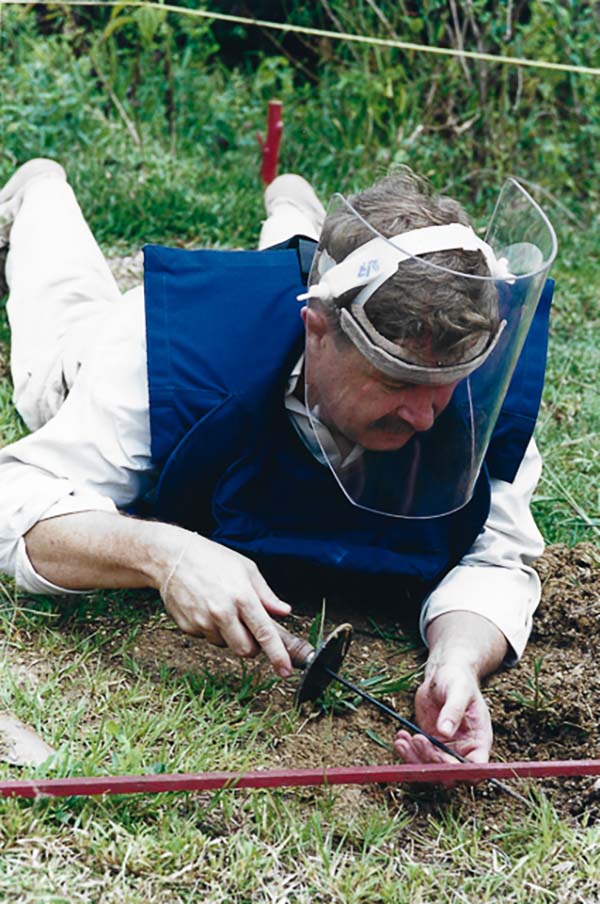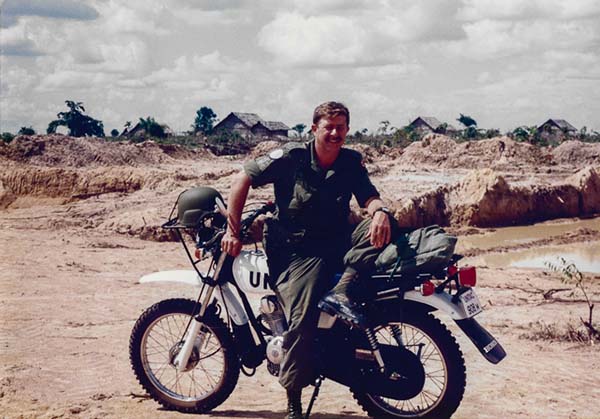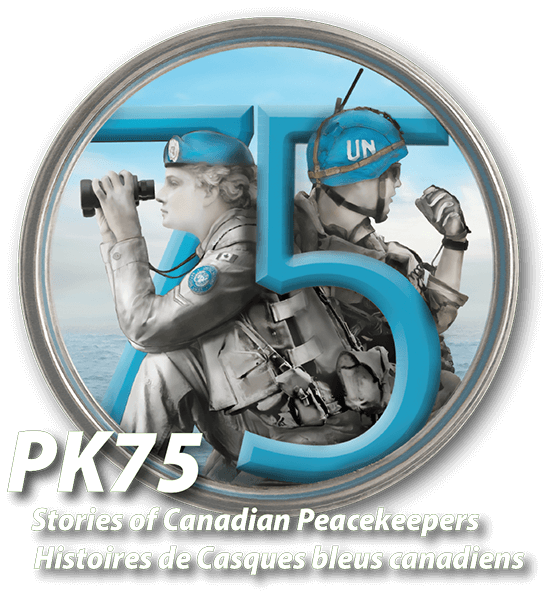



Calgary, AB, Canada
Dave McCracken
Current Location: Thailand
The paradox of my Peacekeeper experience is that I was deployed to combat an enemy who signed no peace treaty, who continued relentlessly to kill and maim innocent victims 24 hours a day, in all seasons. My job was clearing landmines and unexploded ordnance (UXO) in war zones.
Deployed in 1977 to UN Emergency Force (UNEFII) in Egypt, I served as a radio operator and dispatch rider with 73 Signals Squadron. I was based in El Tasa, in the Sinai Desert in the UN Buffer Zone between the Egyptian and Israeli Armies. These duties including the satisfying job of driving a jeep all over the Sinai Desert buffer zone delivering supplies and messages. Negotiating narrow sand tracks, though heavily mined areas I experienced my first encounters with landmines in the Sinai desert.
Operation SALOM was a UN Development Program created to train Afghan refugees to clear explosive remnants of war (ERW). I deployed in 1989 with a Training Team to Peshawar and Risalpur, Pakistan, in anticipation of a million refugees returning to war-torn Afghanistan. It was a challenge teaching illiterate Afghan tribesman the dangerous skills of locating and destroying landmines, included integrating Mine Dog Teams and Demining Platoons. Our Canadian instructors unique “Can‑do” approach adapted highly technical training by successfully working through cultural, and unique language challenges. It was particularly difficult convincing Afghan deminers to trust that dogs are friendly and can smell landmines.
In 1991, 1 Combat Engineer Regiment deployed as part of the UN Iraq-Kuwait Observation Mission (UNIKOM) following the first Gulf War. The mission involved developing a buffer zone between Kuwait and Iraq, building observation posts, safe routes and clearing UXO. My role was supporting our troops in the desert with daily resupply and maintenance. The professionalism of our Canadian Combat Engineers performing their duties, including the clearing of highly dangerous UXO, was inspiring, and a credit to Canada.
Returning from Kuwait, I was immediately redeployed, in 1992, with a quickly assembled team of Engineer experts to the UN Advance Mission in Cambodia (UNAMIC) to prepare safe conditions for the UN Transitional Authority in Cambodia (UNTAC) to implement a national election. I was assigned as Senior Mine (Landmine) Technical Advisor to the Cambodia Mine Action Center (CMAC). Our task was to locate and document all known mined areas and deploy trained deminers. This critical mission enabled landmine-incident-free deployment of peacekeepers, and the return of one million refugees into heavily mined, former battlefield areas so they could vote.
I remained in Cambodia with the Canadian Team for two and a half years, deploying over 2500 deminers in teams throughout the country. This mission was my most rewarding experience in Peacekeeping. I witnessed the unceasing bravery of Cambodians laying down their weapons and taking up mine detectors to free their country of this deadly curse. To this day, CMAC deminers continue to free land from landmines for families to make a living.
Following the Cambodia mission, I returned to Chilliwack, BC, having completed 20 years of proud military service to Canada and the UN. Retiring my uniform, I was recruited by the UN Office for the Coordination of Humanitarian Affairs (UNOCHA) to serve as the Mine Survey Officer for Angola. My primary role was reconnaissance of potential (landmine free) Cantonment sites for the National Union for the Total Independence of Angola (UNITA) guerilla forces to demobilize under UN supervision. The most lasting memory for me is the untreated landmine victims suffering from gangrenous, open wounds in remote towns all over Angola, a situation that continued whilst an endless state of war and negotiations lingered on.
As the peace stalled in Angola, I was recruited to lead a Handicap International project to create an additional Demining Unit for CMAC. Back amongst old friends in Cambodia, I set to the task training, equipping and fielding a Battalion sized unit in Kompong Thom province, the former home of Pol Pot, and still partially occupied by the genocidal Khmer Rouge. The Khmer Rouge put a price on my head (it was only 6000 Thai Baht, the equivalent paltry sum of 240 Canadian Dollars), but thankfully, due to our reputation of freeing up land, local people always informed us of the Khmer Rouge whereabouts, and we kept one step ahead of them.
The U.S. State Department consecutively asked me to set up the Thailand Mine Action Center (TMAC) in 1999 and Iraqi Mine Action Center (IMAC) in 2003. The TMAC program included upgrade training for the Mine Dog School in Pak Chong and deploying Mine Dog teams alongside four border units engaged in Humanitarian Demining. It was rewarding to work with Thai professionals dedicated to removing landmines in border communities.
Arriving in Iraq in June 2003, soon after Baghdad’s liberation, I assisted in setting up IMAC. An insurgency war started, and my mission was to re-employ Kurdish former UN Deminers in Northern Iraq and to develop new Demining Teams from the former Iraqi Army. My lasting memory of this mission is the steadfast courage of Iraqis braving car bombs, mortar, and rocket attacks to come to work every day, without fail, to learn humanitarian demining. Which was a high-risk job in itself.
I am proud to say that, through 20 years of Military service and 25 years of civilian, high-risk, Humanitarian Mine Action missions, no one was killed, wounded, or maimed on my watch. I attribute this to the skills I learned as a Canadian Combat Engineer, from great leadership examples I encountered along the way, and from the good advice received from my comrades in arms and thousands of dedicated Deminers. I’m indebted to those brave men and women who don Deminer uniforms and risk their lives every day. They are my heroes; bless them all.
Biography
My Dad, William (Bill) McCracken, was a veteran of the United Nations (UN) Korean War serving with “C” Squadron, Lord Strathcona’s Horse (Royal Canadians) in 1951. He fought North Korean and Chinese Communist forces who invaded South Korea, then continued his service in the Armoured (Tank) Corps for 25 years. My Mom, Mary (nee Crane) was a young English girl who survived the German bombing of her city Coventry in England, before immigrating to Canada as a Stenographer after World War II.
Born in Calgary, AB on 28 Feb 1956, I lived the nomadic, military family lifestyle, as we were posted around Canada, and overseas to West Germany on two occasions. Growing up in a military family in the 1960’s and 1970’s, one is keenly aware of the menacing Cold War and the possibility of nuclear war.
Following my conscience and father’s footsteps, in 1975 I joined the Army at Canadian Forces Base Lahr, West Germany, completing trades training at CFB Chilliwack, BC at the rank of Sapper. As a Field Engineer, now called Combat Engineer, I embarked on a 20-year adventure. My Canada-based postings included 3 Field Squadron, 1 Combat Engineer Regiment, Canadian Forces School of Military Engineering (all in Chilliwack, BC), and 22 Field Squadron in Gagetown, NB.
I enjoyed an exciting military career involving four rewarding UN Peacekeeping and Development missions in the Sinai Desert Egypt, Peshawar Pakistan, Kuwait, and Cambodia. As a Sapper, my intense training brought unique skill sets in Combat Engineering, Combat Diver, landmine warfare, demolitions and explosive ordnance disposal (EOD). Eventually, I taught and mastered all these skills as an instructor. Fortuitously these skills would eventually save my life and others many times over.
After retiring from the Canadian Armed Forces, I was recruited by the UN, Governments, NGO’s, and commercial companies over a period of another 25 years to work in the Humanitarian Mine Action sector, with projects all over the world, including Angola, Cambodia, Laos, Washington, DC, Thailand, Iraq, Vietnam, Sri Lanka, and East Timor.
My hometown is Chilliwack, BC, where my family resides. My son Blake, with grandson Maxwell, is living in Grapevine, Texas, and my daughter Heather, with granddaughter Nora, is living in Saint John’s, NL. Currently, I’m living in Nakon Ratchasima, Thailand with my wife Tui and continue to engage in Humanitarian Mine Action projects. As of writing this biography Feb 2023, I am participating in a Chemical Weapons Survey in the eastern Provinces of Cambodia, an explosive, toxic remnant of the Vietnam War. Chimo

Demonstrating how to probe for mines.

NE Cambodia minefield survey operations.


